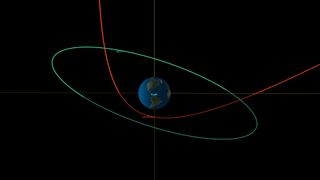Car-sized asteroid will pass extremely close to Earth tonight
Don't worry, we're safe.
Update for 5:15 p.m. ET: The Virtual Telescope Project's webcast of asteroid 2023 BU is now scheduled for 5:45 p.m. EST (2245 GMT) due to clouds.
A small space rock is about to make a super close pass at Earth tonight, but don't worry — we are perfectly safe.
The space rock, named BU 2023, was first spotted hurtling toward Earth on Saturday (Jan. 21) by famed Crimea-based astronomer and astrophotographer Gennadiy Borisov, the same man who in 2018 found the first interstellar comet, which now bears his name, Borisov.
The asteroid BU 2023 is only 11.5 to 28 feet (3.5 to 8.5 meters) wide, which means it would pose no risk to our planet, even if the trajectories of the two bodies were to intersect. However, observations of BU 2023 by other astronomers that followed Borisov's discovery confirmed that the asteroid will miss our planet by a small but safe margin of 2,240 miles (3,600 kilometers). The rock will make its closest approach above the southern tip of South America today (Jan. 26) at 7:27 p.m. EST (0027 GMT on Jan. 27), according to NASA. You can watch a free live webcast of the asteroid's flyby on Space.com, courtesy of astrophysicist Gianluca Masi of the Virtual Telescope Project in Italy, at 5:45 p.m. EST (2245 GMT).
Related: Asteroid apocalypse: How big must a space rock be to end human civilization?

During its closest approach, BU 2023 will be about ten times closer to the planet than the orbit of geostationary weather satellites and nearly six times closer than the orbit of navigation satellites such as the U.S. GPS constellation. This distance makes the rock's pass the fourth closest of any asteroid ever recorded, apart from those that actually hit Earth.
With its small size, BU 2023 poses no risk to the planet at all. If it were to enter Earth's atmosphere, it would mostly burn up, producing a stunning fireball. A few small fragments could potentially survive and fall to the ground in the form of meteorites.
Get the Space.com Newsletter
Breaking space news, the latest updates on rocket launches, skywatching events and more!
The combination of the rock's small size and the close proximity at which it will pass the much larger Earth means that 2023 BU's trajectory will change quite a bit as the rock receives a gravitational kick from the planet, NASA said in the statement.
Calculations based on the latest observations reveal that prior to its visit to Earth, the space rock's orbit around the sun has been "roughly circular" and took 359 days to complete. Earth's gravity will push BU 2023 into a more elliptical orbit, which will take the rock halfway to Mars at its farthest point from the sun. This alteration will add 66 days to BU 2023's orbital period.
The eyes of hundreds of professional and amateur astronomers are expected to follow the encounter tonight and you can witness the close approach, too. For example, Italian astronomer Gianluca Masi will share his observations online onward from 3:45 p.m. EST (1915 GMT) today on his Virtual Telescope Project channel.
Follow Tereza Pultarova on Twitter @TerezaPultarova. Follow us on Twitter @Spacedotcom and on Facebook.
Join our Space Forums to keep talking space on the latest missions, night sky and more! And if you have a news tip, correction or comment, let us know at: community@space.com.

Tereza is a London-based science and technology journalist, aspiring fiction writer and amateur gymnast. Originally from Prague, the Czech Republic, she spent the first seven years of her career working as a reporter, script-writer and presenter for various TV programmes of the Czech Public Service Television. She later took a career break to pursue further education and added a Master's in Science from the International Space University, France, to her Bachelor's in Journalism and Master's in Cultural Anthropology from Prague's Charles University. She worked as a reporter at the Engineering and Technology magazine, freelanced for a range of publications including Live Science, Space.com, Professional Engineering, Via Satellite and Space News and served as a maternity cover science editor at the European Space Agency.
-
SciFi Sam It is my understanding that this asteroid was discovered just last Saturday the 21st of Jan 2023. As such, it underscores just how little we know about "sunward" bodies that are nearly impossible to identify. When looking essentially into the sun's glare, the star field is awash in light that obscures objects that cannot easily be identified. As such, this is an example of an earth-intersecting body (or close to it) with, in this case, relatively little mass that is a likely harbinger of larger objects still unidentified.Reply -
billslugg And combine the Sun's glare with the proliferation of satellites glowing at sunset/sunrise. The result is a potential catastrophe. It might be a good idea to orbit a telescope to do the searching.Reply -
SciFi Sam Astute observation! The proliferation of artificial orbital objects present further challenges to identification of potentially harmful bodies. Sun-synchonous orbital observations provide for greater parallax when searching for these objects.Reply
